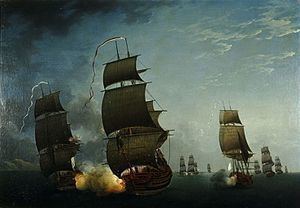Name HMS Ardent Commissioned October 1773 Launched 13 August 1764 Beam 14 m | Ordered 16 December 1761 Laid down 15 January 1762 Construction started 15 January 1762 Length 49 m | |
 | ||
Captured 17 August 1779, by French Navy | ||
HMS Ardent was a 64-gun third-rate ship of the line of the Royal Navy. She was built by contract by Hugh Blaydes at Hull according to a design by Sir Thomas Slade, and launched on 13 August 1764 as the first ship of the Ardent-class. She had a somewhat turbulent career, being captured by the French in 1779, and then re-captured by Britain in 1782.
Career
The Ardent was first commissioned in October 1774 under Captain Sir George Douglas. In 1778, under the command of Captain George Keppel, she was with Admiral Lord Howe's squadron off New York, defending the town from the larger French fleet under the command of Admiral d'Estaing. The two forces engaged in an action off Rhode Island on 11 August, though both fleets were scattered by a storm over the following two days. She returned home to Portsmouth and was paid off in January 1779.
June 1779 saw Ardent recommissioned under the command of Captain Phillip Boteler, sailing from Plymouth in August to join Sir Charles Hardy in the Channel. According to the ship's logs, as many as 4/5 of the crew were landmen, and neither Boteler nor the captain of the Marlborough, in whose company Ardent was sailing, were aware that a French fleet had put to sea. Ardent encountered a fleet two days after sailing, and after receiving the correct replies to the private signal, ran down to meet them. The fleet however was a Franco-Spanish fleet, somehow in possession of the Royal Navy signal code book, thus permitting the correct response to Ardent's signals.
With Ardent within range, the French frigate Junon fired two broadsides before raising her colours. Three further frigates, and the Spanish ship of the line Princesa joined the action shortly afterward. In response, Ardent offered sporadic and inaccurate return fire before striking her colours to the vastly superior enemy force. At his subsequent court martial Captain Boteler blamed his failure to return fire on an inadequate supply of gunpowder for Ardent′s cannons, a statement strongly denied by the ship's gunner Archibald Macintyre who presented evidence there was enough powder for fifty minutes of vigorous engagement. The court martial rejected Boteler's claims, finding instead that the inexperience of the crew was the principal cause of Ardent′s failure to respond to the attack. Boteler was dismissed from the Navy for his failure to adequately defend his ship.
Little is known of Ardent's career in the French Navy; however the British re-captured her on 14 April 1782 following the Battle of the Saintes, and recommissioned her that month under Captain Richard Lucas. On 28 August 1783 the ship was renamed Tiger. She was sold out of the service in June 1784.
